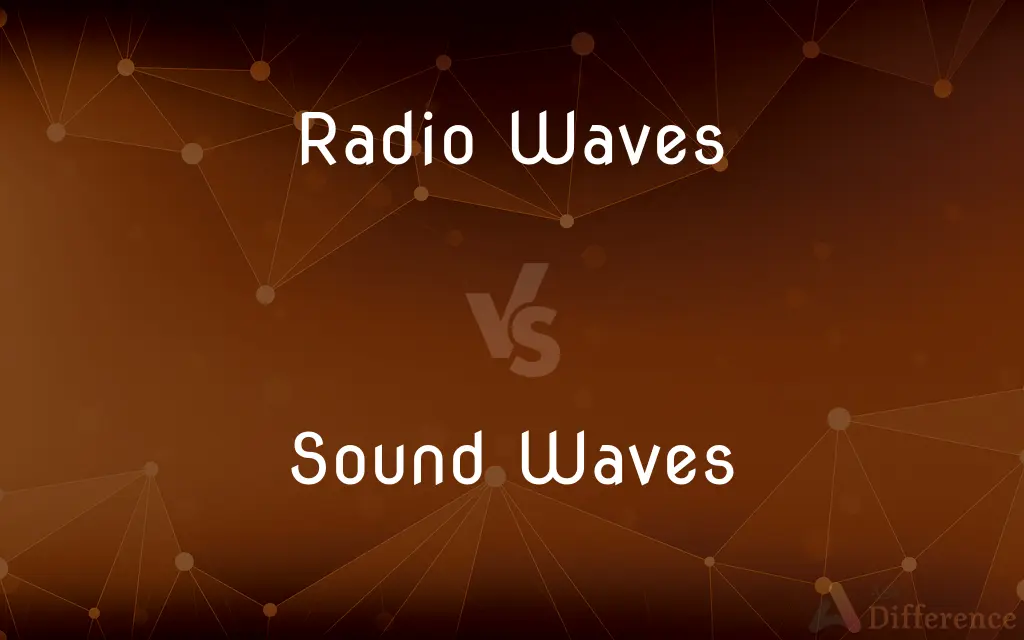Radio Waves vs. Sound Waves — What's the Difference?
By Tayyaba Rehman — Published on November 16, 2023
Radio waves are electromagnetic waves transmitted through the vacuum of space, while sound waves are mechanical waves requiring a medium (such as air) to travel.

Difference Between Radio Waves and Sound Waves
Table of Contents
ADVERTISEMENT
Key Differences
Understanding the nature of Radio Waves reveals their identity as a type of electromagnetic radiation, traversing through space at the speed of light without necessitating a medium. Contrarily, Sound Waves are mechanical vibrations, reliant on a medium—like air, water, or a solid substance—to propagate, and cannot traverse a vacuum like their electromagnetic counterparts. This distinct dependency on a medium for Sound Waves highlights a crucial differential point from Radio Waves.
Radio Waves are emblematic of a broad spectrum of electromagnetic waves, inclusive of microwaves and infrared radiation, characterized by their capacity to travel vast distances through space and different media. Sound Waves are notable for their origination from a vibrating source, generating compressions and rarefactions in the medium, dictating that their propagation speed is influenced by the medium’s properties. It is paramount to note that the speed of Sound Waves is distinctly lower than the swift, constant speed of Radio Waves in a vacuum, which is the speed of light.
When exploring the applications of Radio Waves, one discovers their pervasive utility in communication technology, enabling data transmission over extensive distances, including telecommunications and broadcasting. In a juxtaposition, Sound Waves find their applications in realms like acoustics, communication, and ultrasound technology, whereby their properties are harnessed in both communication between entities and various technological applications. The scope of applications for both wave types is broad, but Radio Waves distinctly lead in long-distance and wireless data transmission due to their ability to traverse a vacuum and various media.
In context, Radio Waves and Sound Waves exhibit various properties that are intrinsically linked to their forms. The former has properties like frequency and wavelength that are not influenced by media transitions, maintaining their integrity across diverse environments. Meanwhile, the latter experiences alterations in speed, frequency, and wavelength when transitioning between media, contingent upon the specific properties of the media involved. It is essential to acknowledge that Sound Waves offer palpable interactions with different media, significantly impacting their properties and behaviors in various contexts.
Finally, the generation of Radio Waves generally involves the acceleration of an electron in an antenna, producing oscillating electric and magnetic fields that propagate through space. Sound Waves, however, are birthed from the oscillation of particles within a medium, necessitating a physical, mechanical disturbance to initiate their journey. Although Radio Waves and Sound Waves share the generic classification of ‘waves,’ their origin, propagation, properties, and applications underscore a multitude of differences, offering varied, yet equally fascinating, realms of scientific exploration and practical application.
ADVERTISEMENT
Comparison Chart
Nature
Electromagnetic wave
Mechanical wave
Medium Requirement
Can travel without a medium (vacuum)
Requires a medium to travel
Speed
Speed of light
Depends on the medium, generally slower than radio waves
Application Examples
Broadcasting, satellite communication
Acoustics, ultrasound technology
Energy Transmission
Through electric and magnetic fields
Through particle oscillations in a medium
Compare with Definitions
Radio Waves
Wireless Communication
Radio Waves are fundamental in enabling wireless communication technologies.
Sound Waves
Media Impact
Transitions of Sound Waves between different media can alter their speed, wavelength, and frequency.
Radio Waves
Speed Constant
In a vacuum, Radio Waves travel at the speed of light.
Sound Waves
Mechanical Vibrations
Sound Waves are mechanical waves, necessitating a medium through which to travel.
Radio Waves
Electromagnetic Nature
Radio Waves are a type of electromagnetic radiation that can traverse a vacuum.
Sound Waves
Medium Dependent
The speed and properties of Sound Waves are influenced by the medium through which they propagate.
Radio Waves
Data Transmission
Radio Waves are commonly utilized in various forms of data transmission, such as broadcasting.
Sound Waves
Particle Oscillations
Sound Waves involve the oscillation of particles in a medium, creating compressions and rarefactions.
Radio Waves
No Medium Needed
Radio Waves can propagate without a medium, unlike mechanical waves.
Sound Waves
Human Perception
Sound Waves in certain frequency ranges are perceptible to the human ear, facilitating auditory experiences.
Common Curiosities
Do Sound Waves need a medium for transmission?
Yes, Sound Waves require a medium like air, water, or solid to propagate.
What are Radio Waves?
Radio Waves are electromagnetic waves that can travel through the vacuum of space.
What is an application of Sound Waves in medicine?
In medicine, Sound Waves are utilized in ultrasound technology to create images of internal body structures.
How are Radio Waves generated?
Radio Waves are generated by accelerating electrons in an antenna, creating oscillating electric and magnetic fields.
How do Sound Waves propagate?
Sound Waves propagate through a medium via particle oscillations, creating compressions and rarefactions.
How is the speed of Sound Waves determined?
The speed of Sound Waves is influenced by the properties of the medium through which they are traveling.
Can Radio Waves travel through space?
Yes, Radio Waves can travel through the vacuum of space without requiring a medium.
Are Radio Waves used in mobile communication?
Yes, Radio Waves are integral for wireless communication in mobile phones and networks.
In what technologies are Radio Waves used?
Radio Waves are used in various technologies like broadcasting, satellite communication, and Wi-Fi.
Can Radio Waves be seen by the human eye?
No, Radio Waves are outside the visible spectrum and cannot be seen by the human eye.
How fast do Radio Waves travel?
In a vacuum, Radio Waves travel at the speed of light.
Can Sound Waves be used for communication underwater?
Yes, Sound Waves are used for underwater communication, as they can travel through water.
Can humans hear all Sound Waves?
No, humans can generally hear Sound Waves within a frequency range of 20 Hz to 20 kHz.
Can Radio Waves and Sound Waves interfere with each other?
No, Radio Waves and Sound Waves do not interfere with each other as they have different natures and propagation mechanisms.
How are Sound Waves generated?
Sound Waves are generated by a vibrating source, which creates mechanical vibrations in a medium.
Share Your Discovery

Previous Comparison
Allosteric Site vs. Active Site
Next Comparison
Genetic Variation vs. Environmental VariationAuthor Spotlight
Written by
Tayyaba RehmanTayyaba Rehman is a distinguished writer, currently serving as a primary contributor to askdifference.com. As a researcher in semantics and etymology, Tayyaba's passion for the complexity of languages and their distinctions has found a perfect home on the platform. Tayyaba delves into the intricacies of language, distinguishing between commonly confused words and phrases, thereby providing clarity for readers worldwide.
















































